Welcome to the belated update covering Week 90 of Putin's War.
As I've discussed for the last month or so, the focus of this war has shifted dramatically from the battlefields in Donbas and Zaporizhzhia to Brussels and Washington. It has become a war of military attrition in the trenches around Avdiivka and a war of political attrition that pits the staying power of President Volodymyr Zelensky's government and of his Western allies against the resilience of Putin's Russia. I'm still of the view that the West, particularly an EU that is increasingly influenced by Poland rather than Germany on this issue is in it for the long haul. I think the US is in for the duration, too. There is a solid Senate majority that favors Ukraine aid, and the anti-Ukraine (and, in some situations, the obviously pro-Russian) members of the House can't stop funding there.
While much of the attention is focused on the US and EU, a couple of interesting things have happened in Russia that bear watching. First, families of mobiks have started to protest, and an increasing number of Russians are openly sympathizing with anti-war Russians. The Afghan War ended for Russia when mothers of soldiers started protesting in Red Square. Families of mobiks are frequently not informed of their soldier's death, they are denied a death gratuity and rarely are the bodies returned to Russia. Disabled soldiers rarely get rehabilitative care and are frequently denied pensions.
RUSSIAN HOME-FRONT BLUES: The families of RU mobniks drafted under Putin's 'partial mobilization' are organizing demonstrations. They're demanding that their men be allowed home leave, and are inviting Russians to join nationwide protests on 19 NOV https://t.co/vyBFHd04pH
— Chuck Pfarrer | Indications & Warnings | (@ChuckPfarrer) November 15, 2023
The outpouring of support for this 33-year-old woman on trial for writing "stop the war" on department store price tags has forced the judge to close the trial to the public.
While 99.9% of Russia's slave population is lost in a deranged, genocidal frenzy, a few sane Russians showed up to court wherein a 33 year old woman faces 8 years in prison for writing "stop the war" on 5 price tags in a department store.
— Jay in Kyiv (@JayinKyiv) November 16, 2023
Judge has now closed it to press. pic.twitter.com/tXdKcyBZSP
Second, and much more significant, Russian media seems to be preparing the population for a major withdrawal in Ukraine in the same way they prepped the public for abandoning the right bank of the Dnieper River and for the "goodwill gesture" they made by retreating from Snake Island.
This "defeatism" only appears on Russian television with official sanction.
Solovyov on the situation on the left bank, you can see how much it pains him to say it 😆 pic.twitter.com/mOwW2hLyll
— Seveer of the 95th (@Reevesity) November 14, 2023
😉 “We have lost logistics between the Kinburn Spit, Oleshki and Novaya Kakhovka,” Kolobok Rogov on Russian TV
— PStyleOne1 (@PStyle0ne1) November 14, 2023
Interesting 😈 pic.twitter.com/UcgJa7ONQB
Here are some of my past updates. For all my Ukraine War coverage, click here.
Putin's War, Week 88. Zelensky Is Blindsided by TIME Magazine and the Offensive Gets a Postmortem
Putin's War, Week 87. The Battlefield Shifts to Washington and Brussels
Putin's War, Week 86. The Very Resistible Force Meets the Immovable Object in Donbas
Putin's War, Week 83. Zelensky Gets ATACMS From Biden and a Cold Shoulder From McCarthy
Putin's War, Week 82. Russia Dissed at the UN and the War Moves Toward Rasputitsa
Putin's War, Week 80. Ukraine's Offensive Continues Slow Progress as Fingers Are Pointed
Putin's War, Week 78. Prigozhin Crashes, Two Russian Bomber Bases and Moscow Hit by Drones
Many more are available at this link.
Politico-Strategic Level
Ukraine's Commander-in-Chief Celebrates Kherson Liberation Anniversary.
On November 11, 2022, the Russian Army tucked tail and ignominiously retreated from the area of Kherson on the right bank of the Dneiper River that it had illegally occupied for over eight months. The takeaway from that campaign is that Russia was forced to withdraw due to maneuver, not sledgehammer blows. Ukrainian artillery cut the bridges across the Dneiper, making all Russian forces on the right bank dependent on what could be ferried across. A secondary topic that hasn't been explored is the degree to which Ukrainian and Russian commanders arrived at an agreement that allowed the Russians to retreat unmolested. In return, the Russians did not resort to scorched earth.
Commander-in-chief Zaluzhnyi shared a video for the anniversary of the liberation of Kherson. pic.twitter.com/AbHCjxuIjL
— NOELREPORTS 🇪🇺 🇺🇦 (@NOELreports) November 11, 2023
My commemoration of that event is a tweet from one of the most pompous, know-nothing, often-wrong-never-in-doubt Russian accounts still cranking out drivel and hogwash every day.

Germany Increases Ukraine Aid
Germany is going to double (!) the planned military help for Ukraine for the coming year. Instead of 4 billions of Euro, Germany will send 8 billions of Euro, making it by far the 2nd largest contributor of all military aid to Ukraine.
— (((Tendar))) (@Tendar) November 11, 2023
That’s impressive.
Source:… pic.twitter.com/efFxmFed2Q
Polish Government Resigns
The Polish PM Mateusz Morawiecki has submitted his government's resignation. pic.twitter.com/iLcWPTblsh
— Visegrád 24 (@visegrad24) November 13, 2023
EU Sees Ukraine as a First Step to Further Expansion
Last week, I posted about EU President Ursala von der Leyen opening talks to lay the groundwork for Ukraine to enter the EU; see Putin's War, Week 89. Zelensky Gets an EU Invitation, the EU Looks East and the Russians Have a Timetable. In the comment threads, my fellow refugee from Lucianne.com, Laocoön of Troy, noted:
Ursula von der Leyen like all EU officials isn't speaking or acting for herself. She is a European bureaucrat and she's articulating a policy that's been discussed and has the support of a rough consensus already. This was probably discussed and decided months if not a year ago. Every word was carefully crafted. You can change the face and name on the briefing document and whoever was speaking it would sound the same. Europeans don't digress from the script.
Indeed.
BREAKING: EU foreign policy chief Josep Borrell says that Ukraine's EU candidacy could "create momentum" for enlargement elsewhere
— Samuel Ramani (@SamRamani2) November 13, 2023
Having made offers to Ukraine and Moldova and accepted the candidacy of Georgia, the EU has placed its sights squarely on the Balkans, probably with the exception of Kosovo and Serbia. This would confront Putin with a massive economic and political competitor all along its western frontier, and it would strip Russia of its messianic role as the protector of Russians and the overlord of Slavs. Combine that with convincing Finland and Sweden to join NATO, Vladimir Putin must be acknowledged as a strategic savant non-pareil...for Brussels and Washington.
Black Sea Grain Corridor Reopens Without Russian Permission
In an amazing accomplishment for a country without a functioning navy, Ukraine has reopened a grain corridor. despite the Russian Navy trying to shut it down.
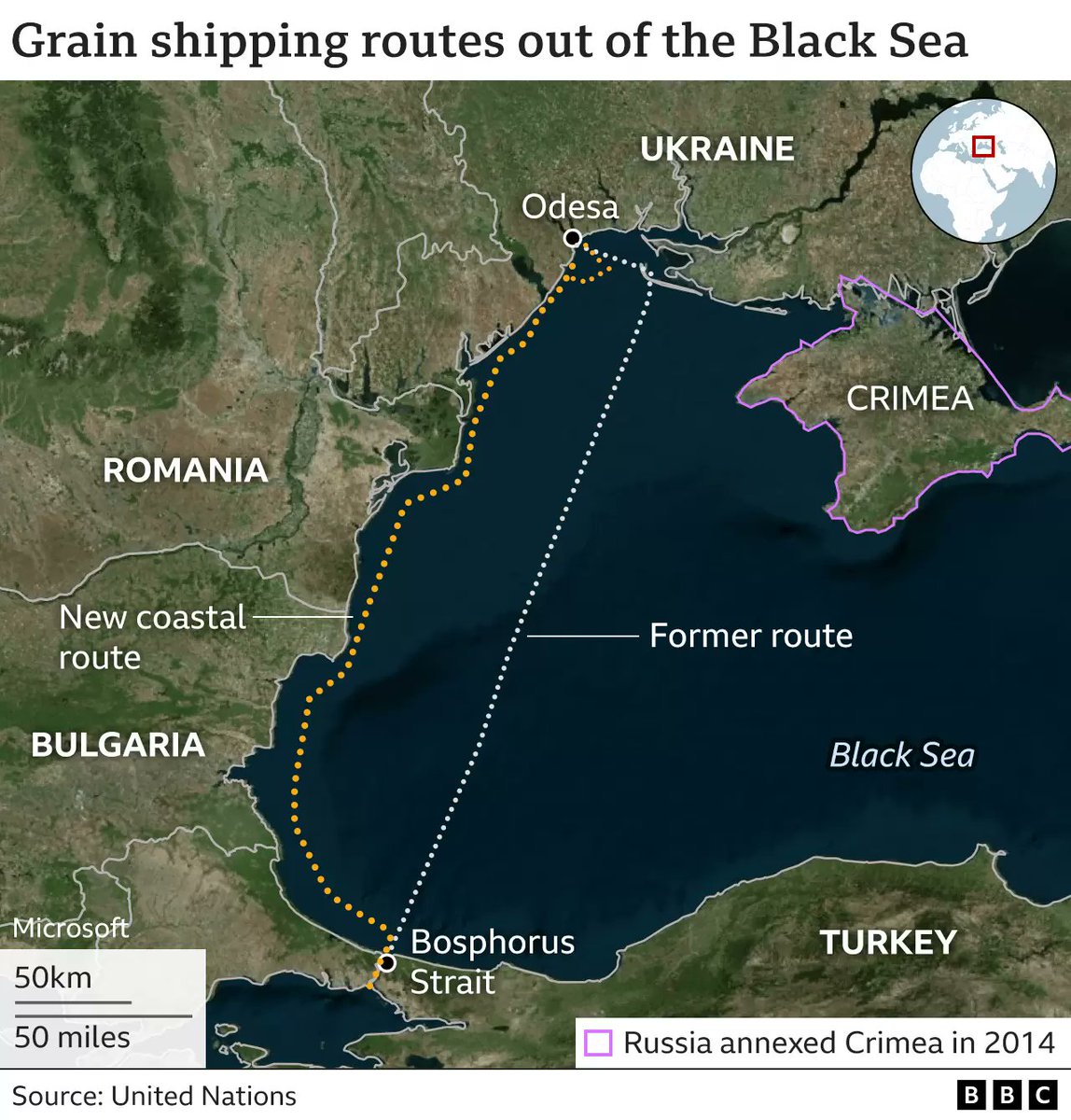
FEED THE WORLD: US Ambassador Bridget A. Brink @USAmbKyiv reports that the 100th ship has departed the Black Sea humanitarian corridor, carrying UKR produce to the world. The functional defeat of the RU navy in the western Black Sea has made this possible. https://t.co/QOJs3fGjSX
— Chuck Pfarrer | Indications & Warnings | (@ChuckPfarrer) November 13, 2023
The Ukrainian government reached a deal with international insurers that will provide affordable coverage to vessels carrying grain and other critical food supplies through the Black Sea corridor for civilian vessels, - ISW#StandWithUkraine pic.twitter.com/OB7OIydf9e
— UATV English (@UATV_en) November 17, 2023
This is a direct result of Ukraine's multi-domain war combining unmanned surface vessels, UAVs, as well as Storm Shadow and SCALP-EG cruise missiles with the impending threat of ATACMS and extended-range Neptune anti-ship missiles to make Sevastopol untenable to Russia's Black Sea Fleet and force them from the southwestern sector of the Black Sea.
Russian Television Shows Why Russia Must Lose
I hear repeated calls in social media and among some of the commenters here that someone, I'm never sure who must bring Russia and Ukraine together to hammer out a deal. What is left unsaid is the outlines of an agreement. That's deliberate, of course, as the Venn Diagram between those demanding negotiations and those fluffing Putin is just one circle.
The reason why negotiations with Russia are futile is because the current Russian power structure doesn't agree that Ukraine is a country. Without that agreement, any ceasefire is merely an opportunity for Russia to rearm and launch another war.
Medvedev (whom Russian themselves call "The Sarmat of thr Russian thought) has launched a new "missile" in his Telegram channel:
— Anton Gerashchenko (@Gerashchenko_en) November 12, 2023
"We must admit that Odesa, Nikolaev, Kiev and practically everything else are not Ukraine at all.
After that there are only three steps until the… https://t.co/VjLB36aBRJ
The only agreement possible is the evacuation of Russian forces from the 1992 borders of Ukraine at independence and providing Ukraine with arms and security alliances to guarantee its independence.
The Battle Over the Narrative
One of the reasons for this phenomenon may be Russian influence operations. Reporters run in packs because being wrong in a group is safer than being right by yourself. They also tend to be captured by experts, particularly journalists, and follow their lead. When some of those journalists and academic experts are on the Russian payroll, it influences the narrative. And the narrative often shapes public opinion and government policy.
Big and not very surprising yet important journalistic scoop. For years, Hubert Seipel, a leading 🇩🇪 journalist and popular Russia expert, was on the Russian payroll. Let’s not be naiv, even without direct payments, the RU influence network in 🇩🇪 is bigger than many understand. https://t.co/vS8IUPcQIH
— Mattia Nelles (@mattia_n) November 14, 2023
Taking Out the Trash
As I've noted several times, the argument that we should not help Ukraine because it is "corrupt" is a rather flimsy one. If your objection is to corruption, Ukraine is much less corrupt than Russia and is getting less so. Russia continues to get more corrupt. Even accepting that argument, the Zelensky government is using the war to clean up corruption that would have been very difficult to attack during peacetime.
Alexander Dubinskiy, a current member of the #Ukraine's Parliament has been slammed with another, bigger criminal charge: a high treason and participation in a criminal organization. It took years for the Ukrainian law enforcement to charge Dubinskiy with that after the U.S.… pic.twitter.com/7S4zg9ob9Z
— Viktor Kovalenko (@MrKovalenko) November 13, 2023
I Hate It When That Happens
Lieutenant General Vladimir Sviridov, former commander of the Russian Air Force and Air Defense, found dead with his wife. What caused their death is unknown. Only one thing is clear: in russia, representatives of the top military leadership continue to die mysteriously. pic.twitter.com/foeTuaIKPG
— Roman Sheremeta 🇺🇦 (@rshereme) November 16, 2023
Operational Level
The operational picture remains the same as last week. Russia continues to attack in several areas. The offensive operations focus on cutting off the Ukrainian salient at Avdiivka. I assess the other offensive operations around Kupiansk and Bakhmut are designed to freeze Ukrainian forces in place and possibly force Ukraine to reinforce those efforts to the detriment of the defense of Avdiivka. The Russian goal is two-fold.
First, provide Putin a tangible victory as he "campaigns" for "reelection." Reducing the Avdiivka salient would boost morale, quieten the voices counseling peace, and give control of most of the historical boundaries of Luhansk and Donetsk Oblasts.
Second, demoralize Ukraine's government, its military, and its backers in the West.
In my view, it is a huge gamble that is predicated on Russia being able to sustain the losses they are suffering.
Summary Execution as a Leadership Technique
Like Mike Ford, I'm convinced that the operational center of gravity in this war is the staying power of the Russian Army. I don't post every terrible story I see because troops in every army are notorious whiners and complainers (as my first First Sergeant told me, "Sir, a soldier has a right to bitch"). Sometimes, things that are significant pop out.
In occupied Berdiansk, a Russian commander shot dead a Russian soldier in front of his comrades.
— Anton Gerashchenko (@Gerashchenko_en) November 10, 2023
According to soldiers, the murdered man was "an ordinary, decent man", and the reason for the shooting, as the commander said, was an alleged insult. The commander shot the soldier… pic.twitter.com/SjU8iDCf01
Functioning armies do not resort to summary executions. The fact that troops are sufficiently incensed to make a video about it is an indication of how seriously they take it and how little faith they have in their chain of command. A commissioned officer gunning down a soldier in what amounts to a personal dispute indicates that discipline in that unit has all but collapsed.
This is not the only hint that things aren't well. I'll confess to never having served in the Russian Army, but if I or one of my officers or NCOs had treated even the most noxious dirtbag private like this, we'd have been afraid to go anywhere alone or to sleep. Perhaps the people serving in the Russian Army, of all ranks, are so morally degraded that this is considered acceptable. If so, it makes an excellent case for sending Ukraine more cluster munitions.
the second army of the world
— bigSAC™ (@bigSAC10) November 14, 2023
Because everybody knows REAL armies beat the shit out of junkies and refuseniks instead of using a judicial process. Due process is for pussies. https://t.co/ZxjaZQufUQ
Kherson A$$ Whooping: Part 3
— OSINT (Uri) 🇺🇦 (@UKikaski) November 15, 2023
You can see how moral has improved since Parts 1 and 2.
The accusation is that these Russian soldiers were on drugs and did not assault the enemy resulting in the unit being defeated. In reality, this is what you get for not participating in a meat… pic.twitter.com/03Sa4PprbS
Shell Hunger
I contend that the war in Ukraine was nearly a godsend for the US and its allies in Europe and Asia. For thirty years, the free world has let its defense industrial base erode. While the US defense industry proudly points out its high-tech products, the blue-collar part of the industry has nearly collapsed. During the Base Realignment and Closure craze that followed the demise of the Soviet Union, ammunition plants, one of the largest sectors of the industrial base, were targeted for elimination.
As it turned out, that wasn't a great idea. Not only were factories closed, but the facilities that made the machine tools to make machinery to build new factories were dismantled. We've discovered there were human skills involved, like "sweating" solid explosives into liquid, that were nearly lost. The ammunition consumption rates in Ukraine rival those in World War II's European theater. Supporting Ukraine has snapped the West out of its slumber before it has to face China in a war somewhere.
#Ukraine's Foreign Minister Dmitro Kuleba confirmed on November 13 that the EU is behind in the delivery of 1 million artillery shells, citing the poor state of the European defense industry
— RoINTEL (@RoINTEL) November 14, 2023
Next year, things will dramatically improve. The US is bringing new factories online.
Northrop Grumman (NOC.N) is exploring producing 120 millimetre tank ammunition in Poland as the U.S. ally surges defence production capacity, the company's chief told Reuters on Thursday.https://t.co/g4fWmja7Pl pic.twitter.com/A7gKYI3uQO
— 𝔗𝔥𝔢 𝔇𝔢𝔞𝔡 𝔇𝔦𝔰𝔱𝔯𝔦𝔠𝔱 🇬🇪🇺🇦🇺🇲🇬🇷 (@TheDeadDistrict) November 16, 2023
Rheinmetall has taken over Spain's moribund ammunition industry and is pumping in money (Putin's War, Week 75. Putin Cucked, Moscow Droned Again, and the Industrial War Hits High Gear – RedState). It is also activating its mothballed factories (Putin's War, Week 73. Putin Eludes Arrest, Black Sea Grain Initiative Dies, and Ukraine's Offense Continues to Grind Away – RedState). Fourteen countries are now producing ammunition for Ukraine.
So, yes, the EU is behind on deliveries, but that is a temporary affair. And the Russian ammunition problem is at least as severe, and I don't think Russia has the reserve capacity to match that emerging in the West.
Black Sea Order of Battle
The Ukrainian Armed Forces carried out another attack on Russian ships in Crimea. I've covered that attack below. As retired Lieutenant General Ben Hodges said, making Crimea untenable for the Russian military; see Putin's War, Week 89. Zelensky Gets an EU Invitation, the EU Looks East and the Russians Have a Timetable.
This chart shows the collective effect of the successful campaign a non-naval power has conducted against the Black Sea Fleet.
I'll try to make a more accurate chart of Russia's order of battle for the Black Sea Fleet at the start of the Russo-Ukraine War and I'll do red and yellow X's to denote ships that are damaged or destroyed. I know I'm missing a couple below but we're getting close to the Black… pic.twitter.com/16i6ciFQhs
— Intelschizo (@Schizointel) November 10, 2023
It doesn't reflect the fact that most of the Russian ships stationed at Sevastopol have been moved to other bases (Putin's War, Week 88. Zelensky Is Blindsided by TIME Magazine and the Offensive Gets a Postmortem), or surface combatants that have moved to the Mediterranean.
OOA activity - Update
— Droxford Maritime (@Drox_Maritime) November 11, 2023
Russian Navy Black Sea Fleet SKR-494 “Adm Grigorovich” entered the Mediterranean Sea during the evening 10 November 2023. Vessel will highly likely continue to the Levant region. An outstanding catch by Team @Gibdan1 https://t.co/8qKoQCsWTy
About to Bring the Hammer Down
Last week, I posted about a Ukrainian brigade hit by a Russian missile strike as it held an awards ceremony; see Putin's War, Week 89. Zelensky Gets an EU Invitation, the EU Looks East and the Russians Have a Timetable. The incident not only gutted a very competent combat unit, but the widespread distribution of images of the event shamed the Ukrainian Army. The Defense Ministry has investigated, and action against the people who thought this was a good idea seems imminent.
Rustem Umerov, Minister of Defense of Ukraine: "The Chief Inspectorate of the Ministry of Defense reported the results of the investigation into the circumstances of the missile attack on the 128th Mountain Assault Brigade. Now we know, minute by minute, what happened and how it… pic.twitter.com/leLXFn9H4U
— Dénes Törteli 🇪🇺🇭🇺🇺🇦 (@DenesTorteli) November 14, 2023
USAF Releases Contract for Training Ukrainian F-16 Pilots
If training fighter pilots for Ukraine is to be a long-term project, it requires stability in the instructor force. A new solicitation by the Air Force indicates that is exactly what is planned.
The U.S. Air Force is looking at potentially contracting out F-16 training for international pilots.
— Brian Everstine (@beverstine) November 13, 2023
A new solicitation looks for companies with the aircraft and pilots to train 30 students per year.https://t.co/1RzquAlSSd
As the USAF was standing up a long-term training program, Romania announced it was opening an F-16 pilot training center serving NATO and Ukraine.
Romania is NATO's center of gravity in the greater Black Sea region. Terrific Ally.
— Ben Hodges (@general_ben) November 14, 2023
Romania inaugurates an F-16 jet pilot training center for NATO allies and neighboring Ukraine https://t.co/FsqWEtgCaq
Rheinmetall and Ukraine Partnership Expands
Rheinmetall and Ukraine are developing a relationship critical to Ukraine's long-term security. Rheinmetall operates another repair facility jointly with Poland and is building a tank factory in Ukraine (Putin's War, Week 74. The Crack in the Russian Wall Appears and Ben & Jerry's Employees Join the Russian Army – RedState).
2/Rheinmetall has been given a contract by the Ukrainian government to provide 25 Leopard 1A5, 5 Bergepanzer 2 armored recovery vehicles, and 2 driver training tanks. The order is funded by Germany and also includes maintenance, spare parts, training, and other support services. pic.twitter.com/aBITtv2Ngp
— Artur Rehi (@ArturRehi) November 14, 2023
Russia Moves More Air Defense Systems to Ukraine
According to UK intelligence, Russia is moving air defense systems that protect other parts of Russia to the Ukrainian theater of operations. This shows the attraction of air defense systems in theater and the inability of Russian industry to make the systems as fast as they are being destroyed.
Latest Defence Intelligence update on the situation in Ukraine – 09 November 2023.
— Ministry of Defence 🇬🇧 (@DefenceHQ) November 9, 2023
Find out more about Defence Intelligence's use of language: https://t.co/MgupPTc3RQ
🇺🇦 #StandWithUkraine 🇺🇦 pic.twitter.com/tny17Z7a2o
New Weapons
Caracal
#Ukraine will be the first user of Rheinmetall's Caracal airmobile platforms! The company will supply Ukraine with 5 of these vehicles from the end of 2023 to the beginning of 2024. Financed by the German government.
— German Aid to Ukraine 🇩🇪🤝🇺🇦 (@deaidua) November 14, 2023
The Caracal is a 4x4 mobile platform specially designed to… pic.twitter.com/sYDB9rX9BB
Combat Operations
Sustaining Combat Power
This is one of the key differences between the two armies fighting in Ukraine.
⚡️🇺🇸American armored repair and evacuation vehicle M88A2 Hercules, which is in service with the Armed Forces of 🇺🇦Ukraine, evacuator damaged in battles M2A2 Bradley ODS-SA BMP. 🇩🇪German tank tractor MAN HX81 is also used for evacuation pic.twitter.com/yFdWlVMP3a
— 🇺🇦Ukrainian Front (@front_ukrainian) November 11, 2023
Where most disabled Ukrainian vehicles are repairable and recovered, most Russian vehicles disabled in combat never return to action. The crew abandons them, and there is no attempt made at recovery. The video circulating on Telegram indicates that there are Ukrainian drone units dedicated to destroying abandoned vehicles. The larger problem is that we're seeing that a majority of Russian vehicles hit by ATGM, tanks, 30mm auto-cannon, drones, artillery, whatever, are catastrophic kills; that is, they blow up.
This makes a huge difference in sustaining combat power.
Russian Attacks Near Adiivka
I'll talk more about the ongoing Russian assault on the Ukrainian salient at Avdiivka. That fighting is producing a lot of video, and rather than cluttering up the discussion of the battle, I'll drop it in here.
A field near Avdiivka after another Russian "meat-wave" assault, covered with destroyed equipment and dead Russian soldiers. pic.twitter.com/UQFS4fgG8T
— English Luhansk (@loogunda) November 12, 2023
Video from another failed Russian assault near #Svatove in the #Avdiivka sector.
— OSINT (Uri) 🇺🇦 (@UKikaski) November 17, 2023
AFU sources report "observing the accumulation of (enemy) resources" presumably in advance of another major assault.
Although the Russians have made some advances in the area in the last weeks,… pic.twitter.com/ppKH8AW0Sf
Captured by a Russian drone: Ukraine's Bradley infantry fighting vehicles in action in Stepove village, #Donetsk region. #MilitaryOperations #DroneFootage #Ukraine 🇺🇦🚁🎥pic.twitter.com/2DdmhbtYRr
— Shankar Narayan (@theconcis) November 16, 2023
The Vanishing Ka-52
The Ka-52 has been critical to Russia's success in stopping the Ukrainian Spring Offensive. That airframe is becoming more scarce. The first reason is that the more you use a weapon system like an attack helicopter, the more of them you lose. The Russians started the war with a maximum of 133 Ka-52. Russia has produced an estimated eight new helicopters since the war began. There is visual evidence of 58 losses verified by oryxspioenkop.com before it closed its doors on October 1 and a claim of 10 losses to MANPADS since then. At least ten were lost in the ATACMS strike on two Russian airbases (Russia Claims US ATACMS Missiles Hit Two Airbases in Occupied Ukraine – RedState). In a best-case scenario, there are 55 Ka-52 remaining, and we have no information on how many of those are flyable and the operational readiness rate of the flyable ones. I would be shocked if over a third of the remaining Ka-52 fleet could get airborne at one time.
The second factor is that the Russians have pulled their forward-based helicopter fleet back to Rostov-on-Don. This means Ka-52s must move to forward area rearm and refuel points (FARPs). They must return to their permanent base to do routine maintenance or repair battle damage. It is a process that increases crew fatigue, uses more fuel, and results in fewer combat sorties and more incidental losses to mechanical failure.
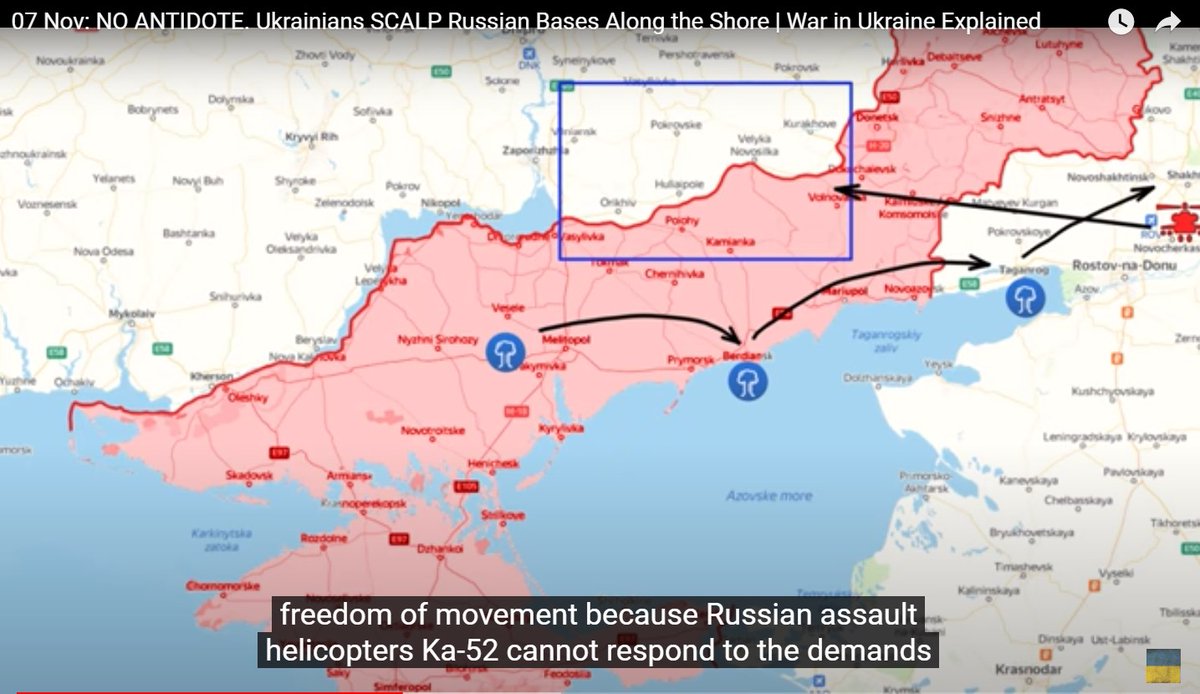
More Gepards
The Gepard, an obsolescent air defense system, debuted in Putin's War only 71 weeks ago, Putin's War, Week 19. Political Uncertainty, Lots of New Weapons, and a Replay of the Western Front. Since then, it has become an indispensable tool in protecting units and point targets from drones and missile attacks. More of them have been pulled out of mothballs and are on their way to the front lines.
The US bought 60 Cheetahs (Dutch Gepards) from Jordan to be transferred to Ukraine.
— (((Tendar))) (@Tendar) November 13, 2023
Source: https://t.co/elAb7AKvd3#Ukraine #Jordan #USA pic.twitter.com/OT3uVXuc0q
Something Old, Something New...
Ukraine is not only using German Gepards but is also using much older systems. Here is a Soviet ZU-23-2 23mm antiaircraft gun in action. Instead of shooting at ground targets, it is being used to engage aerial targets, which is something this system hasn't done since the Vietnam War.
⚡️Rare footage of the destruction of the 🇷🇺Russian kamikaze drone "Shahed-136" from the Zu-23-2 anti-aircraft gun this morning https://t.co/cbDrDUWb9c pic.twitter.com/z2I5ZdgnwG
— 🇺🇦Ukrainian Front (@front_ukrainian) November 16, 2023
The War on Drones Continues
Here, a Ukrainian unit with the mission of attacking Russian drone crews and launch sites. I have questions about the effectiveness of this attack. Are the guys who carried the man away part of the drone launch team? Was there a follow-up attack to eliminate the drones that can be seen on the roof?
Still, it shows that being a drone team member is every bit as hazardous as duty on the front lines.
Ukrainian drone pilots tracked down the Russian FPV launch point from the roof of a building, and landed their FPV there. The Russian pilot was curious and ran to see what kind of drone had landed. The Ukrainian drone then took off and eliminated the Russian pilot.… pic.twitter.com/5Ef54AIjNy
— Samuel Bendett (@sambendett) November 13, 2023
In Donetsk Oblast, Ukrainian Special Ops Forces (SSO) adjusted HIMARS fire onto Russia's UAV crew, preparing to launch a "ZALA" drone. The strike destroyed the UAV crew, their vehicle, and the UAV itself.
— Euromaidan Press (@EuromaidanPress) November 17, 2023
📹 via https://t.co/hPudLAVEyf pic.twitter.com/sxi10Y3e2w
Su-25 Shot Down
This is the eighth Su-25 strike fighter lost near Avdiivka since October 10.
Video from the downing of a Russian Su-25 over #Avdiivka today.#OSINT #Counteroffensive #UkraineRussiaWar #UkraineWar #Ukraine pic.twitter.com/HRosmE4IJV
— OSINT (Uri) 🇺🇦 (@UKikaski) November 15, 2023
Tactics, Techniques, and Procedures
You Can Run, But You Can't Hide
I've frequently commented on the profound change the presence of cheap and lethal drones is bringing to the battlefield. Multimillion-dollar tanks are reduced to smoldering scrap metal by a grenade dropped from a drone. Drone artillery spotters are making "shoot and scoot" a dangerous option for self-propelled artillery. Now, the impact is filtering down to how infantry squads operate. In this video, for reasons that aren't clear, a Russian squad shelters in a burned-out BTR armored personnel carrier. As it turns out, that wasn't a great idea.
A group of Russian soldiers tried to hide inside a destroyed BTR but were still taken out by an FPV Kamikaze drone in the Avdiivka (Donetsk region) pic.twitter.com/gf4S2Zs8ot
— OSINTNic (@OSINTNic) November 13, 2023
In this video, a two-man Russian MANPADS team is to cover the area of the Ukrainian bridgehead in Kherson and was spotted by a Ukrainian reconnaissance drone controlling an FPV suicide drone.
The Security Service of Ukraine fines Russian motorcyclists for speeding.https://t.co/wg2LQ1jgF6 pic.twitter.com/xkNhyprYmU
— Special Kherson Cat 🐈🇺🇦 (@bayraktar_1love) November 12, 2023
Here a "Scooby Doo" van used by the Russian Army to transport troops tries to evade a drone. I have to give the driver credit for skill and effort.
Bukhankaaaa pic.twitter.com/CPJvN8bHGQ
— 𝔗𝔥𝔢 𝔇𝔢𝔞𝔡 𝔇𝔦𝔰𝔱𝔯𝔦𝔠𝔱 🇬🇪🇺🇦🇺🇲🇬🇷 (@TheDeadDistrict) November 17, 2023
This is a Russian "chase car" detailed to follow a homeward-bound Ukrainian FPV to enable its launch point to be discovered. No...they obviously would follow it through the front lines.
FPV footage from inside a Russian vehicle while it is being chased by a Ukrainian FPV drone. pic.twitter.com/MojfA97NCl
— Dmitri (@wartranslated) November 14, 2023
Quantity Versus Quality
These are two great threads on how FPV drones are augmenting ATGM on the battlefield. TL:DR version: an FPV capable of disabling or destroying a tank or armored vehicle costs a couple of hundred dollars. A Javelin ATGM system runs around $178,000, with replacement missiles costing $78,000; even less sophisticated weapons will cost at least $20,000. Do the math.
This is one of the most poignant testimonies as to why FPV drones are replacing direct fire ATGM on the battlefield.
— Trent Telenko (@TrentTelenko) November 15, 2023
Only drones can provide the necessary mass of precision guided munitions for a modern battlefield.
Lt. Chornovol is buying 4 drones a month because it is
1/ https://t.co/0oJAyCuZ8M
Northern Front
Kharkiv
Kupiansk
Russian offensive activity seems to be winding down. There were seven reported attacks on this front. None of them gained ground.
Bring me my Spear: O clouds unfold:⁰Bring me my Chariot of fire!
— Challenger Tank In Ukraine🇬🇧🇺🇦 (@ChallengerInUA) November 17, 2023
The Russians, supported by a tank and two BMPs, decided to attack the positions 🇺🇦14th brigade in the Kupiansk direction.
A BMP and Tank get hit by Javelins while a 2nd BMP hits a mine🔥🍞
pic.twitter.com/w6oJRCor86
This is what the front line looks like. The slashed gray areas are the "gray zone" or no-man's land.
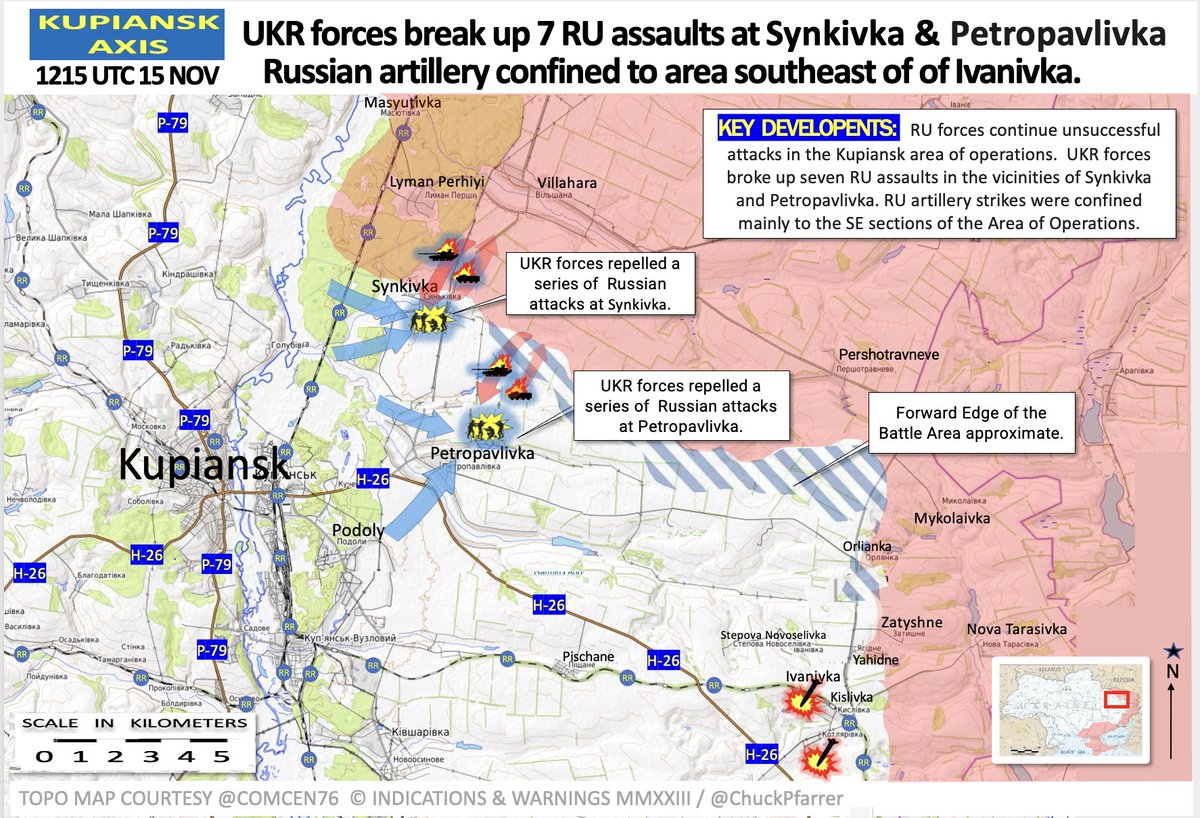
Ukraine had one minor victory.
Ukraine achieved a small military victory in Kharkiv this weekend
— Samuel Ramani (@SamRamani2) November 12, 2023
It captured the village of Topoli and raised the Ukrainian flag over its territory
Russia's Kupiansk axis Kharkiv offensive has likely been extinguished for now
Donbas
The Russians continue strong attacks in this area. The operations around Bakhmut are focused on stopping the Ukrainian attempt to outflank Bakhmut to the south and force the Russians to abandon it. The operations at Adiivka are aimed at reducing the Ukrainian salient there and reclaiming a fortified area that has been in Ukrainian hands since the first Russian invasion in 2014.
Bahkmut-Klishchiivka-Andriivka
The main Russian focus remains north of Bakhmut, with the Russian Army making some small gains.
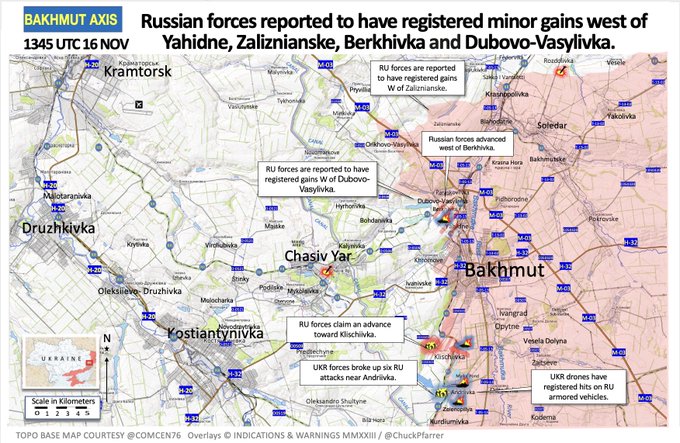
The Russians had less luck south of Bakhmut at Klishchiivka.
East of Klishchiivka, Russians tried to attack Ukrainian positions. Before they reached their intended position, they were destroyed by defenders of the 93rd mechanized brigade. pic.twitter.com/Td3FlKmRd8
— NOELREPORTS 🇪🇺 🇺🇦 (@NOELreports) November 15, 2023
Russian troops have been trying to enter Klishchiivka for weeks but it all ends in a way similar to this footage. They are getting blown up by mines, ATGMs or artillery.
— (((Tendar))) (@Tendar) November 15, 2023
Source: https://t.co/iyhcqSpCJx#Ukraine #Bakhmut #Donetsk pic.twitter.com/X0ijGXFWVd
Adiivka
This fighting in this area continues to be intense. The best estimates are that the Russians have gained about 250 meters at the shoulders of the salient since their operation began in mid-October. This is a critical sector for both sides. If Russia can capture an area Ukraine has fortified since 2014, it will be a psychological blow in the way Bakhmut could never be. The Russians probably have committed more troops to the effort than Ukraine, but Ukraine has committed more tanks, infantry fighting vehicles, and artillery than Russia.
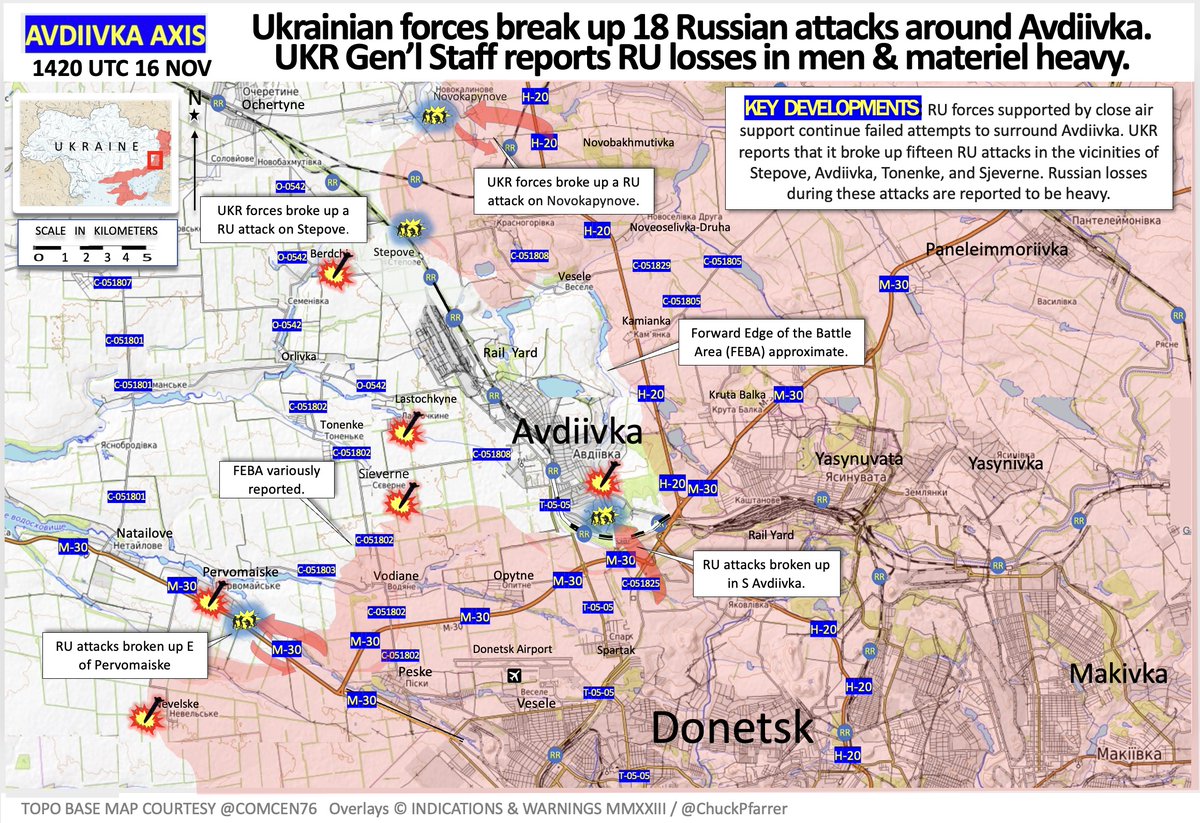
⚡️🇺🇦Ukrainian military from the 59th Separate Motorized Infantry Brigade repulses a 🇷🇺Russian attack in the Avdiivka area using FPV kamikaze drones pic.twitter.com/83p1kUi7uG
— 🇺🇦Ukrainian Front (@front_ukrainian) November 11, 2023
🇷🇺 Russian leave their own and take away the tent cloak, Avdiivka region pic.twitter.com/ZrvtknHtfB
— Slava (@Heroiam_Slava) November 16, 2023
Urozhaine-Vuhledar
Russia has increased combat operations in this sector in the last two weeks without significant gains.
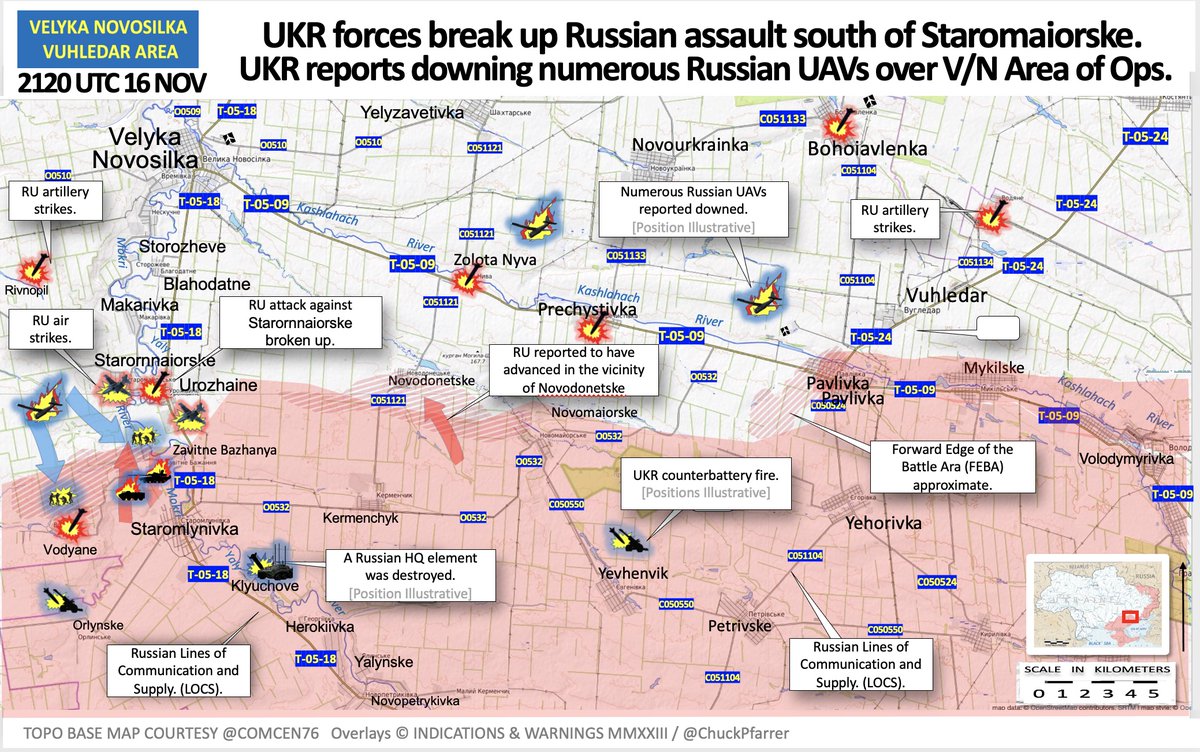
Drone School Hit
I've previously posted on the ferocious war going on targeted drone operators; see Putin's War, Week 86. The Very Resistible Force Meets the Immovable Object in Donbas and Putin's War, Week 88. Zelensky Is Blindsided by TIME Magazine and the Offensive Gets a Postmortem. This is another facet of this battlefield.
Multiple reports indicate that Russia's combat drone operator training center in Donetsk, occupied by Russian forces since 2014, was hit by an alleged Ukrainian HIMARS strike. Russia's TASS disclosed the facility earlier this year.https://t.co/8nnSViiDqX
— Euromaidan Press (@EuromaidanPress) November 7, 2023
Partisan Activity
Another Pro-Russian collaborator has been eliminated. Mikhail Filiponenko was blown up in his own car in Russian-occupied Luhansk. He was a notorious butcher, organizing torture camps and being directly involved in abuses.
— (((Tendar))) (@Tendar) November 8, 2023
I must say that the Ukrainian intelligence is quite… pic.twitter.com/o1nPFCfUg3
Southern Front
Zaporizhzhia
Robotyne-Verbove- Novoprokopivka;
This was the site of the main Ukrainian effort in the Spring Offensive. Operations are continuing, and the focus of Ukrainian attacks seems to be west of Robotyne rather than southwest of Verbove as they have been all summer. Russian milbloggers reported Russian airstrikes west of Robotyne in an area that had been thought to be under Russian control, indicating some Ukrainian progress.
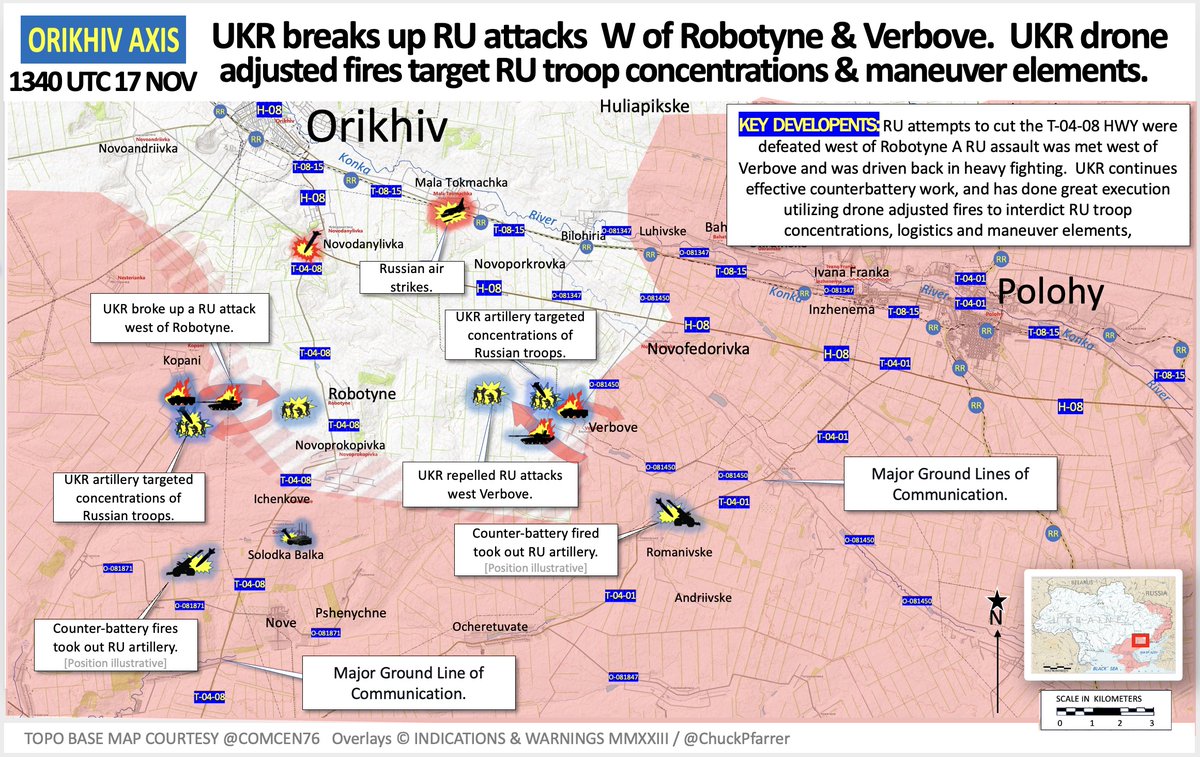
Partisan Activity
An explosion occurred in Mariupol. On Metallurgov Avenue, the car of one of the occupation corps policemen was blown up. “already given a gift” to policemen for the celebration of Police Day in the Russian Federation.… pic.twitter.com/gzLvb9pVXX
— nobumaru ina🇺🇦 (@InaNobumaru) November 10, 2023
Kherson
The slow-motion offensive in Kherson may have hit an unexpected sweet spot. The Ukrainian Spring Offensive drew away a lot of the forces defending Kherson Oblast south of the Dnieper River. The Ukrainian interdiction campaign against the rail lines running north from Crimea and east from Russia has made the supply situation perilous. The operational tempo to the east has restricted the resources available to the Russian occupation force in Kherson. All of this puts the Russian commander in Kherson in a very difficult position.
While the Ukrainians had been very quiet about this operation, last week, Zelensky and the Ukrainian military felt comfortable enough to place his prestige on the line by touting this offensive.
The Kherson region's left bank. Our warriors.
— Volodymyr Zelenskyy / Володимир Зеленський (@ZelenskyyUa) November 17, 2023
I thank them for their strength and for moving forward.
Glory to everyone who restores freedom and justice to Ukraine!
🇺🇦🇺🇦🇺🇦 pic.twitter.com/5Da2key0KA
The Armed Forces of Ukraine for the first time officially confirm their entrenchment on several bridgeheads on the left bank of the Dnipro river in the temporarily occupied part of Kherson region.
— Anton Gerashchenko (@Gerashchenko_en) November 17, 2023
This was confirmed on the Marines' Facebook page:
"As a result of pre-planned… pic.twitter.com/t9R5XE1no6
This is the frontline today, as best I can tell.

It is essential to notice that Russian counterattacks are coming from the east, not the south. This shows the inability of the Russians to confront the river crossings head-on.
💥Very pleasurable bonking by Saint HIMARS of a 11-unit 👹 ammo-carrying supply column in Hladkivka, 25 km south of the 🇺🇦 Dnipro bridgehead
— 🇺🇦Ukraine Resists Russian Genocide... Yeah Again (@ArmedMaidan) November 10, 2023
📌Recon drones are essential for such pinpoint accuracy
🚁Without them, Ukraine would need 3-4 more shells#Ukraine #UkraineRussiaWar pic.twitter.com/hHu8QeCMjt
Unheard of just 6 months ago, with Russians now pushed back, Ukrainian Forces cross the Dnipro River like it's a pleasure cruise. pic.twitter.com/7tgQc4ltF4
— Jay in Kyiv (@JayinKyiv) November 10, 2023
A Russian withdrawal would make a lot of sense in light of the situation across the front.

A withdrawal to a defensible line, approximately where I've drawn the dotted line, could do a lot of things.
- The land bridge to Crimea would not be in greater danger than today.
- Crimea would be just as defensible as it is with the surrendered territory.
- The shorter line is more defensible and would have a higher troops and equipment density than today.
- The withdrawal would draw Ukrainian troops across the Dneiper and subject them to air and artillery attacks.
- The Ukrainians would be forced to install ribbon bridges across the Dneiper to support their advance, and these bridges would be logistical chokepoints that could restrict Ukraine's ability to sustain any significant offensive.
The downside, of course, is that the move would give aid and comfort to Ukraine, to the West, and the growing anti-war movement in Russia. Given the statements made on Russian television and the operational advantages of withdrawal versus the political downside, it would not be unreasonable for a plan of this kind to be in the works.
Russian Missile Attacks
The Russian military attacked one of Kherson's hospitals. An ambulance and other cars were destroyed. Further information about possible victims is being clarified, governor of the region Oleksandr Prokudin reports... pic.twitter.com/fVZnE4Uvsg
— NOELREPORTS 🇪🇺 🇺🇦 (@NOELreports) November 13, 2023
This video shows the aftermath of the Kherson Oblast Regional Library, which was significantly damaged by Russian occupiers on the night of Nov. 12.
— The Kyiv Independent (@KyivIndependent) November 12, 2023
📽️: Oleksandr Prokudin / Telegram pic.twitter.com/Q8rQGOBMAY
Retaliation
Krynky... local Communists report that the Armed Forces of Ukraine burned all the cars; pic.twitter.com/3FSpyogQR8
— Astraia (@astraiatwt) November 11, 2023
Rear Areas
Crimea
More Russian Ships Attacked
several surface kamikaze drones successfully attacked Sema class small landing boats in Uzkaya Bay in western Crimea. pic.twitter.com/rLBVHtSg3U
— Greyskull (@FreudGreyskull) November 10, 2023
There are reports of at least 3 Ukrainian surface drone attacking a number of landing ships in Uzkaya Bay of north Crimea near the village of Chernomorske. One ships having a Russian BTR aboard. https://t.co/9TMByNZxzl pic.twitter.com/ko7QjNfsbZ
— Geopolitical Hub (@GeopoliticalGu1) November 11, 2023
Partisans
Ukrainian partisan members of the "Atesh" movement infiltrated the territory of the Russian Black Sea Fleet military unit in Feodosia, Crimea.
— Dr. Khaled Alfaiomi (@Alfaiomi) November 17, 2023
They documented precise locations, including vehicle garages, ammunition depots, barracks, and the command headquarters, of unit #80393. pic.twitter.com/QTBrXk3Ofv
Raids
The GUR showed unique footage of the preparation and implementation of raids on the territory of the temporarily occupied Crimea. pic.twitter.com/VGnjzJJYvy
— ✙ Albina Fella ✙ 🇺🇦🇬🇧🇫🇷🇩🇪🇵🇱🇺🇸🇨🇦🇦🇺 (@albafella1) November 16, 2023
Before you go on the longest known jet ski raid - insertion into fortified Crimea
— GWAR69 🇩🇰🇺🇦 (@GwarWorin) November 16, 2023
200+ km pic.twitter.com/aJ4rU7kDE8
Russia
FSB Border Troops Commander Ambushed
The target of the ambush was FSB Lieutenant Colonel Sergey Shafy, a senior border troops officer. You can read more about it at this link: Russian Volunteer Corps Fighting Against Kremlin Releases Video of Intelligence Officer Ambush (kyivpost.com).
RDK (Russian Volunteer Corps) showed footage of the ambush on a Russian FSB officer in Bryansk Oblast. The officer did not survive.https://t.co/UCru0lrjAQ pic.twitter.com/tIRLGsb1qV
— Dmitri (@wartranslated) November 10, 2023
Russian Military Base on Fire
This base has storage facilities for surface-to-air missiles and fuel.
A Russian military base is on fire in Krasnodar Krai. Russia.#OSINT #Counteroffensive #UkraineRussiaWar #UkraineWar #Ukraine pic.twitter.com/P0SIgHwEhr
— OSINT (Uri) 🇺🇦 (@UKikaski) November 14, 2023
Russian Explosive Plant of Fire
A large explosion at the gunpowder factory in Russia's Kotovsk, Tambov Oblast. Ukrainian channels claim that it was a Ukrainian drone attack pic.twitter.com/1w6CllCP8Z
— Giorgi Revishvili (@revishvilig) November 10, 2023
DEEP STRIKE: @officejjsmart reports that a UKR drone has struck a propellant and gunpowder factory near Kotovsk, Russia. The target was more than 300 KM (180 miles) from the Ukrainian frontier. Explosions are continuing. https://t.co/Xv6L9f1Gq5
— Chuck Pfarrer | Indications & Warnings | (@ChuckPfarrer) November 10, 2023
Partisans
BLOOMBERG: Russia Opens Terror Probe Into Train Derailment Linked to IED. An “improvised explosive device” was behind Saturday’s freight train derailment southeast of Moscow in which 19 cars were thrown off the tracks, according to Russian authorities. pic.twitter.com/cMKPvBPEiF
— News and Market (@newsandmarket) November 11, 2023
More On Russian Defense Industry Fires
Interesting that Ukrainian intelligence is being coy on this. https://t.co/hi8bIz7vpk
— Phillips P. OBrien (@PhillipsPOBrien) November 14, 2023
In his substack, to which I don't subscribe because Phillips Obrien is a know-it-all-twatwaffle who I'll read for free but who I'll not pay, thinks this is the opening of a larger scale campaign by Ukraine targeting Russian production and transportation.
What's Next
I'm not sure either side can afford to take the winter off like they tried to do last year. The Ukrainian Army will not suffer in the field the way the Russians are going. The big thing to watch is any major change in the morale of either side. I think the proliferation of smartphones can create a perfect storm where the "folks back home" can get daily updates on how much things at the front suck. The phones also allow troops in many units to coordinate activities.
There seem to be some cracks in the relationship between Zelensky and his commander-in-chief, that are open to exploitation given the right conditions. If the low-level sniping between the president's advisors and the military increases in volume, that will be a dangerous position for the Ukrainian war effort.
Operationally, I think we can expect that the Russian offensives will burn themselves out with little to show for it. The big question is, did the Ukrainian command learn anything from the Spring Offensive, and will they have time to impart lessons to the troops in the field?
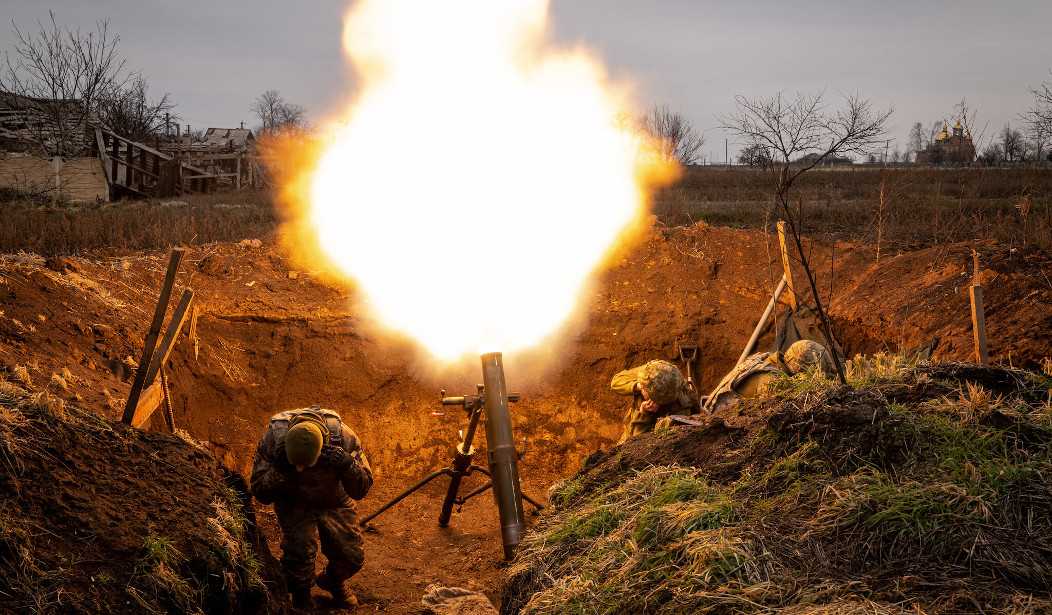











Join the conversation as a VIP Member